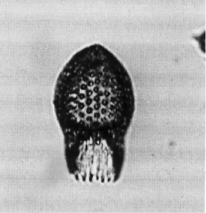 Carpocanopsis
favosa (Haeckel)
Carpocanopsis
favosa (Haeckel) Carpocanopsis
favosa (Haeckel)
Carpocanopsis
favosa (Haeckel)Cycladophora favosa Haeckel, 1887, p.1380, pl.62, figs.5-6; Riedel, 1954, p.172, pl.1, fig.2 (non fig.3)
Carpocanopsis favosum (Haeckel), Riedel and Sanfilippo, 1971, p.1597, pl.2G, figs.15-16, pl.8, figs.9-10
Carpocanopsis favosa (Haeckel) Sanfilippo and Riedel, 1973, p.531
Cephalis obtusely cap-like, commonly marked off externally from the thorax by a slight change in contour. Thorax barrel-shaped, with smooth or slightly rough surface and circular pores usually not showing marked longitudinal alignment. Lumbar stricture usually pronounced externally; in rare specimens the shell wall is very thick, even to the extent of filling the external lumbar stricture. Abdomen usually truncate-conical, widening distally, hyaline and commonly longitudinally ribbed, terminating in a row of irregular teeth; but in rare specimens similar to that of C. bramlettei (Riedel and Sanfilippo, 1971).
Based on 15 specimens. Total length 105-155 mm. Maximum breadth of thorax 70-95 mm (Riedel and Sanfilippo, 1971).
This species is distinguished from C. cingulata and C. cristata by the abdomen being hyaline, and widening distally. It differs from C. bramlettei by not showing marked longitudinal alignment of the thoracic pores (Sanfilippo, unpubl. data)
This species occurs in low latitudes and ranges from within the Cyrtocapsella tetrapera Zone to within the Calocycletta costata Zone.